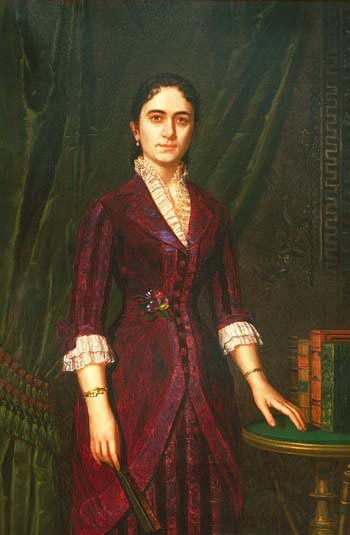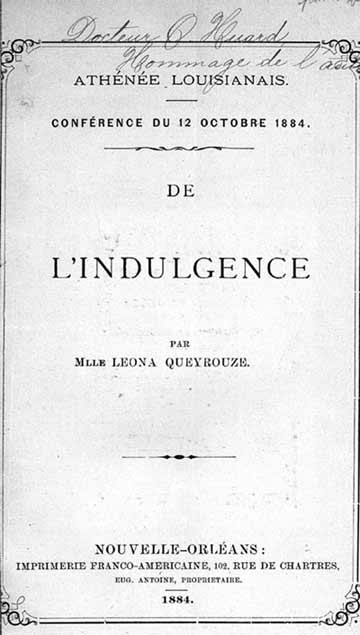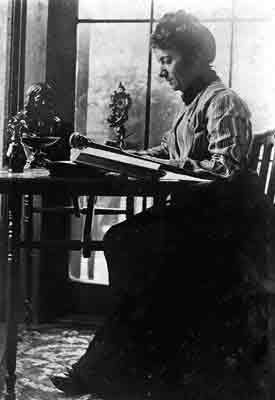First and
Last Days of Paul Morphy
 was
an unpublished memoir by Léona Queyrouze, written under the pseudonym
Constant Beauvais, covering her experience with Paul Morphy. was
an unpublished memoir by Léona Queyrouze, written under the pseudonym
Constant Beauvais, covering her experience with Paul Morphy.
The little-known, hand-written manuscript is retained at the The Williams Research Center of the Historic New
Orleans Collection (part of the Kemper and Leila Williams Foundation) at 410
Chartres Street,
New Orleans.
Fortunately the buildings of the
The Historic New Orleans Collection
were spared from the worst that Katrina dished out. The
homepage wryly states, "The
Historic New Orleans Collection is open to the public, Tuesday through
Saturday, excluding holidays and hurricanes from 9:30 A.M. until 4:30 P.M."
Madam Queyrouze wrote this in 1938 just
prior to her death at age 77. She was almost blind so her original draft of
huge handwriting on large sheets of paper (she eschewed all attempts to
learn how to type) had to be transcribed by her younger brother, Maxim, who
read aloud what he had transcribed, allowing her to make corrections before
he scripted the final draft. Even the final draft was written on 76 sheets
of lined paper with penciled in corrections scattered throughout. Maxim
attempted to have it published posthumously, but found no interested
publisher.
Léona Queyrouze,1880 by John Genin
(1830-1895)
Léona Queyrouze was born on February 23,
1861.
Her family, like Morphy's, were wealthy
Creoles. Her father was Leon Queyrouze, born in 1818, the son of the
first officer of Napoleon’s empire. Though born in France, he came to New
Orleans in 1830. He attended college in Lexington Kentucky. A few years
later, he continued his studies in Havana, Cuba, and returned to New Orleans
in 1835. He worked as a clerk, then a business owner and finally a wine
merchant. He joined the Orleans Guard Battalion as a major, eventually
serving P. G. T. Beauregard as a colonel. He was wounded at Shiloh and
arrested while convalescing in New Orleans. He escaped to Cuba, eventually
making his way to Mexico, serving under General Mejia at Matamoras along
with other former confederate soldiers. Returning to New Orleans, Leon
reopened his business, advertised as "Wholesale Grocer: Importer of Wines
and Liquors." The family owned a plantation named "Leona" in St. Martin's
parish, but their home was located at 17 St. Louis Street, New Orleans. Leon
became prominent as president of the Democratic Club, l'Union Francais,
and the Casadoras Association, while he also helped found the prestigious
Athénée Louisianais, basically a Creole association the purpose of which was
to preserve and promulgate the French culture in Louisiana. He died on
January 18, 1895 at age 77.
Her mother, Anne Marie Clara Tertrou, was
the daughter of Laurent Tertrou and Louisa Beauvais. Léona would later adopt
Beauvais as part of her pseudonym, Constant Beauvais.
Léona was privately tutored and her
curriculum was as rigorous as her parents' expectations were high. She
studied Greek, Latin, Philosophy, European Literature, Science, Music and
Art. Then at 15, she was sent to France to complete her education. She
became fluent in French, English, Spanish, Italian German, Latin, Greek and
Creole. One of the unusual aspects of her education involved participating
in the Queyrouze salon soirées hosted by her father at their home to which
were invited the brightest minds in Louisiana for discussion of religion, literature and
philosophy. Because of her precocious involvement in this group, people
referred to her as "little Mme. de Staël," (Germaine Necker, baronne de Staël-Holstein
was an extremely popular woman writer in Europe at that time, noted for her
advocacy of women rights and for her affairs du coeur).
She took fencing instruction from the
fencing master, C. S. Jones, as did her brother Maxim. Her brother became
the Southern Fencing Champion but freely admitted that his sister was the
better of the two of them. She had been described as “a pretty young Creole
woman with black hair and brown
eyes” and a "young, pretty girl, unmistakably a Creole from her jet black
hair and deep
brown eyes..." A petite woman, approximately 5'4", she was also described in
a New York magazine as "short, dark, very foreign-looking with an arm on
which the flesh is hard as marble from her constant use of the fencing
foils, big mystical eyes and a masculine mouth."
She took music and piano lessons from
Thelcide Morphy. In 1885 two of her works, Victory
Military March and the Fantaise Indienne were performed for the
for the World Cotton
Centennial Exposition in New Orleans by the 8th Calvary of the Mexican Army
Band, directed of Captain Encarnación Payen.

When Léona returned from studying in France, she met a Times
Democrat reporter named Lafcadio Hearn (who would later become a locally
celebrated writer). With his encouragement she published some poems in
the French language newspaper, L'Abeille de la Nouvelle-Orléans under
the pen-name Constant Beauvais (her grandfather's actual name).
In 1880 her Étude sur Racine (Essay
on Racine) was published in Les Comptes-Rendus de l'Athénée
Louisianais. She broke traditional thinking by giving the first public
speech by a woman in Louisiana - a public reading of her essay Étude sur
Racine for the Athénée Louisianais at the Grunewald Hall on
Baronne Street. She gave a lecture on religious tolerance, entitled
Indulgence at the Union Francaise in 1884 and in 1887 she gave a third
lecture entitled, Wagner and Patriotism at the Continental Guards
Armory on Camp Street
1885-6 found her in New York City translating
French dramas and adapting them for American audiences.
Besides her own name and that of her
grandfather, Constant Beauvais, Léona published poems under the names
Salamandra [Greek for Fire-Lizard] and Adamas [Greek for
Unconquerable] in a wide variety of publications from the Time Democratic
and The Crusader (as well as the French language Les
Comptes Rendus de l’Athénée Louisianais and L'Abeille de la Nouvelle-Orléans
and the Spanish language El Moro de Paz) in New
Orleans to the El Buscapie in Puerto Rico. Among her better
received poems were "Vision," “Atlas,” “Magdalena,"
“Moise,” “Samson,” and “Ce qu’ont dit les montagnes.”
Mostly due to her adherence to the French
style rather than the more modern and commercially suited styles, her fame
never extended much beyond her immediate locale (with a few exceptions - one
being a tribute to her from Mr. Combes, president of the Academy of Sciences
and Letters in Bordeaux, France: Ce sont de beaux vers que ceux que vous
avez bien voulu m’offrir de la part de Mlle Leona Queyrouze, votre petite-fille,
et il y a lá l’imagination et l’âme d’une vrai poète de l’école deLamartine
et de Victor Hugo)
The Queyrouze salon soirées introduced Léona
to an exceptional array of local luminaries among which were Charles Gayarré
(who wrote The Creoles of History and the Creoles of Romance and
History of Louisiana); Placide Canonge (journalist, art critic, and
director of the French opera house); the poet Charles Testut (also
editor-in-chief of Les Veillées Louisianaises and author of
Portraits Littéraires de la Nouvelle-Orléans and three historical
novels); Dr. Alfred Bubos, editor of L’Abeille; Louisiana
Supreme Court Justice Alcibiade de Blanc; novelist Mollie Moore Davis (The
Virginian and Under the Man-Fig) whose husband edited the
Picayune; the most remarkable Father Adrien Rouquette a missionary
to the Choctaw Indians who wrote La Nouvelle Atala; General P. G. T.
Beauregard; Dr. Armand Mercier, a distinguished Creole physician; Dr.
Alfred Mercier, author of Habitation St. Ybars, and on whom the
French government bestowed the title “Officier de la Légion d’Honneur”;
Rudolph Matas, president of the American Surgical Association and considered
the father of modern vascular surgery; and, of course, the subject of her
final sketch, Paul Morphy, once chess champion of the world.
All these people, and others, Léona knew and
conversed with since her childhood.
Paul Morphy was 23 when Léona Queyrouze was
born - the same age she was when Morphy died. Her highly stylized
biographical sketch supposedly idealizes Morphy whom she knew all her life.
She wrote that his “most salient characteristic always was an invincible
aversion to popularity, which gradually developed into an unusual disdain of
celebrity.”

Léona married Pierre Marie Etienne Barel at St. Mary's
Church in New Orleans on Dec. 26, 1901 at age 40. Not much is known about
Barel who died long before Léona. From the lack of loving references
to her husband from among her papers, their marriage is considered to have
been more one of convenience than one of love.
Even into her final years, she dwelled in the faded tapestry
of what was once the Creole culture she tried so hard to preserve.
The Civil War, the Americanization of New Orleans, the blurring of the
races that delineated and defined the Creole bloodline, all conspired to
vaporize and dissipate the entire culture, leaving only some vague residue
devoid of any real substance.
Léona Queyrouze died of congestive heart
failure in January, 1938. She was 77 years old.
|
Agonie
by Constant Beauvais
24 Août 1911
|
Mon âme avait jadis une chère patrie
Où le chêne puissant de l’amitié croissait.
Pour soutenir le ciel sa cime se dressait
Et ses rameaux chantelent à l’ étoille fleurie.
A son ombre s’ouvrait, fille de l’Ionie,
La tendre violette; et sans peur mûrissait
La moisson de l’espoir q’un rayon caressait
Etait-ce donc un rêve en mon âme meurtrie?
Quel insecte a rongé le bel arbre vainqueur?
Quel parasite a bu la sève de son coeur?
On n’entend plus les chants dans la haute ramée;
Une pesante nuit tombe de l’au delà;
L’étoille s’est eteinte et la fleur s’est fermée.
C’etait un rêve, helasun reve tout cela!
|
Once my soul held a cherished vision
and like a tree, it grew in strength and love.
Its very summit held the skies aloft
with branches blooming among the stars.
The night sky opened for the daughter of Ionia;
the tender violets bloomed without fear,
the harvest of hope blessed by light.
So when were the dreams of souls broken?
What insidious worm began to gnaw at its core?
Which parasite drank up the sap of its heart
and silenced the music of the heavens?
Leaving my soul in the darkness of tombs
with its stars extinguished and blossoms closed.
It was a dream, alas! A dream all!
|
Much of the biographical information, as
well as the above poem and it's translation, was gleaned from the
doctorate dissertation of
Donna M. Meletio, a
poet in her own right. |

